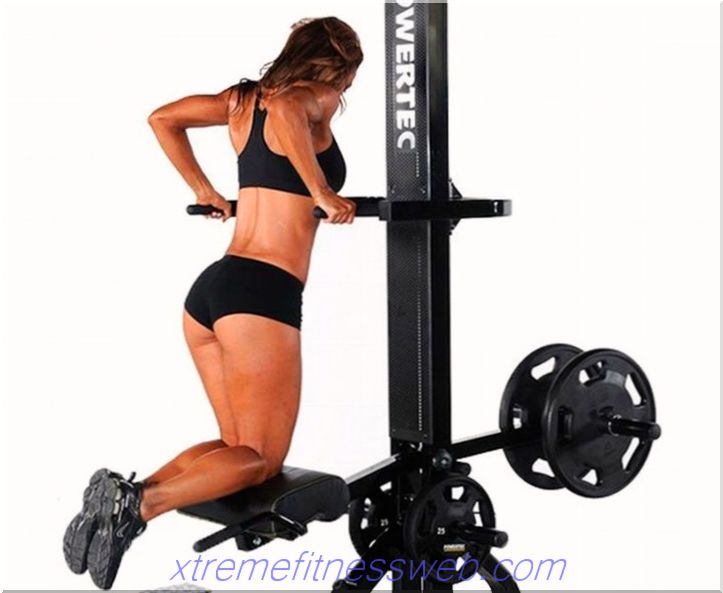- Hyperextension: Description
- What muscles work
- Hyperextension Technique
- 4 reasons to start hyperextension
- Hyperextension Options
- How to avoid injury ">

The lower back is considered the most vulnerable part of the body. She is most exposed to stress. Only twenty percent of adults can boast of a complete lack of pain in this area. This means that performing hyperextension requires maximum caution, since the main load, and, most importantly, stretching is on the muscles in this part of the spine.
To avoid injury, you need to follow a few simple rules that apply not only to sports, but also to everyday life:
- Lifting heavy objects is necessary not with the efforts of the back, but with the legs. If you strain your back, you can easily injure her.
- Делать гиперэкстензию не от случая к случаю, а регулярно. Лучше всего, конечно, ежедневно. Это позволит укрепить самую уязвимую часть тела.
- Контролировать свой вес. Ожирение негативно отражается на общем мышечном тонусе, состоянии здоровья и, безусловно, на спине.
- Растягивать спинные мышцы каждый день. Это позволит избегать излишнего напряжения в этой области.
Огромное значение для профилактики травм в поясничной области имеет питание. Пища должна быть богата минералами и витаминами, а не представлять собой пустые калории. Чтобы не пришлось бороться с лишним весом, если такая предрасположенность есть, имеет смысл периодически устраивать разгрузочные дни.
Summarizing

Some athletes do hyperextension using their own weight from a prone position, that is, without any additional devices. There are those who practice this exercise exclusively using a special bench. The latter option, according to many, has a greater effect, but not everyone practices this approach. Even many of those who regularly visit the gym do not use a bench.
This situation is due to the fact that not all athletes know how to correctly hyperextension with this sports simulator. This does not mean that you need to continue to ignore this projectile, since it is it that allows you to extract the maximum benefit for training your back. It is enough to simply study the technique of performing hyperextension, depending on which particular muscle group you want to focus on in training.
Content
- 1 Hyperextension: Description
- 2 What muscles work
- 3 Hyperextension technique
- 3.1 Important recommendations
- 4 4 reasons to start hyperextension
- 5 Options for performing hyperextension
- 5.1 With a bench angle of 45 °
- 5.2 45 ° with extra weight
- 5.3 On a bench with a 90 degree slope
- 5.4 Focusing on the back
- 5.5 Focused on the buttocks
- 5.6 With emphasis on hip biceps
- 5.7 Hyperextension on fitball
- 5.8 Hyperextension to strengthen the lower back muscles
- 6 Avoiding Injury "> 7 Summary
Hyperextension: Description

This exercise relates to strength. To provide support to the body, it must be performed in a Roman chair. The correct technique of performing hyperextension allows you to strengthen the buttocks, muscles of the core and lower back. This exercise is often called back extension. Often, athletes simply do not include it in their training program or do not pay due attention, but resort to it only as a way to diversify activities. It is inferior in popularity to deadlift and squats, but this is an absolutely undeserved omission. Hyperextension works well on the back, thigh biceps, buttocks.
Extending the back in a Roman chair involves many joints. Refers to traction exercises, the main emphasis of which is on the biceps of the thigh and the extensor muscles of the spine, but with the involvement of the leading and gluteal muscles as auxiliary. The advantage of hyperextension is that it can be performed by both advanced and novice athletes. The main thing is to master the correct execution technique, which will allow you to get the maximum benefit from the exercise.
What muscles work

To assess the benefits of back extension on a bench, you need to become familiar with which muscle groups are involved in this exercise:
- Straightening spine. Represents the target muscle, which accounts for the main emphasis during hyperextension. It is involved both in straightening the back at a right angle (90 degrees) to form a parallel to the floor surface, and when straightening the body at an acute angle (45 degrees).
The muscle responsible for straightening the spine is a group of bundles articulating with the pelvis, ribs, and spine. They are located along the entire length of the spine. Their strengthening has a beneficial effect on the posture and the correctness of the bends of the spine. - Extension hips. Includes buttocks and muscles located on the back of the hips. They, as a straightening one, are involved in performing any variant of hyperextension. The hip extensors, similar to the muscles of the cortex, if not given proper attention, begin to weaken. This is true not only for those people who do not lead an active lifestyle. Often, even in training, they are little involved. Thanks to hyperextension, they regain their tone.
- Extension of the neck. These extensors are small and located on the back of the neck. They are responsible for the mobility of the cervical spine. These muscles must be strengthened. This is especially true for people spending a lot of time at the computer. They wake up and activate when they put their hands on the head or neck, performing hyperextension. This option is considered complicated.
The effectiveness of extension of the back on the bench is not in doubt. The main thing is to know how to do this exercise.
Hyperextension Technique

Hyperextension is done as follows:
- Lie down on the bench face down, and legs in the lower legs are fixed in special areas.
- The body is straightened, crossing arms in front of the chest, thereby assuming the initial position.
- Keep your back straight and exhale, slowly dropping down to the maximum possible.
- The lowering of the body should be due to inhalation of air so that both the lower dorsal and biceps of the femoral muscles are stretched.
- They begin to rise upward, exhaling. It should be clearly felt how all the muscle groups that the exercise is directed to contract.
This procedure is stored in each repetition.
Important Tips

To get the most out of the exercise, you need to consider several important nuances:
- It is not recommended to lower the enclosure below a comfortable level. The hips and back should be stretched, but without any obvious feeling of discomfort.
- Straightening, as well as lowering, should not bring unpleasant feelings in the back.
- To complicate hyperextension allows stretching the arms, holding the load in front of the chest, and also the option when the exercise is performed with one leg.
- You should not try to take too much weight. If you do not calculate your own strengths, this exercise to stretch muscle groups will become traumatic.
If there is no special bench, you can use the usual one.
Important!
There are three different variations in performing hyperextension, which are often confused. Backextension is an option in which the movement is carried out exclusively in the lumbar and dorsal regions, and the femoral muscles remain motionless. Hypextension is the opposite of the previous variety, as the movement falls on the hip joint, and the lower back is motionless. During hyperextension, both the lumbar and hip muscles work.
4 reasons to start hyperextension

Externally, a bench designed to perform stretching of the muscle groups of the back and hips looks rather strange. This simulator is in almost any well-equipped gym. The device is designed for the isolated study of muscle groups located in the lower back. The main emphasis falls on this area.
Benches of this kind come in two varieties. For beginners, varieties with a slope of 45 degrees are suitable. Advanced athletes can work out on the simulator with a 90-degree tilt. Both types of benches bring equal benefits and work out the same muscle groups. The difference lies in the level of difficulty of the exercise associated with the distribution of the load.
Hyperextension performed on the Roman chair allows you to get the following positive effect:
- Improve your posture. Stretching on the bench strengthens the cortex and spinal muscles. This leads to better back support throughout the day, and, therefore, has a beneficial effect on posture.
- Reduces pain in the back. People whose work is associated with prolonged sitting often have to face the fact that their back begins to hurt regularly. Hyperextension greatly facilitates this condition. Strengthening the back becomes an excellent base for preparing for such strength exercises as deadlift.
- Strengthen the body. Stretching affects the lower back, but, along with the main accent muscles, the entire body is worked out. Even hands are involved in the work, so the benefit is felt absolutely in the whole body.
- Increase Stamina. For athletes who want to improve their athletic performance, hyperextension allows you to create a good base for intensive training with traction, squats and other exercises in which the lower back is directly involved.
The main advantage of the simulator for hyperextension is that this projectile easily adapts to the individual needs of the athlete.
Hyperextension Options
Stretching the lower back involves not only the use of different tilt angles of the simulator, but also a shift in emphasis. Depending on the variation of the exercise, the technique of execution also changes.
With a bench angle of 45 °

To perform hyperextension on such a projectile, it is necessary:
- Adjust the simulator so that there are no obstacles that hamper the movement, and then position the feet as tightly as possible in the place provided for this.
- Cross your arms in front of the chest and hyperextension from this position when the body is in a straight position.
- Bend the body at the waist, and then lower to the floor. The angle of inclination should be from 65 to 75 degrees.
- Hold in the adopted position for a while, and then slowly rise to the initial position, that is, to the position when the back and legs are in one straight line.
45 ° with extra weight

This exercise can be complicated. This should be done already after the full development of the technique and the regular implementation of hyperextension, when it begins to be given easily, and the muscles get used to the load and become stronger. As a burden, it is best to use a bar or a pancake. The first shell can either be held in front of you or behind your head.
On a bench with a 90 degree tilt

This variant of hyperextension seems incredibly complex to many. For beginners, it is really not recommended to perform it. For those who regularly train, and have an intermediate or advanced level of training, it will not be difficult to do it. The complexity of this option lies in the fact that the point of movement shifts, since the body completely hangs from the bench, and the body at the top point passes only a small horizontal mark.
Do not be afraid to lean toward the floor. If you still do not feel full confidence in your own strengths, you can insure yourself with your hands until the exercise becomes familiar. The rollers holding the legs in the calf area do not allow falling from the bench. Before performing the exercise, you need to make sure that the upper platform of the bench is at the level of the upper femoral part, and not at the level of the legs or abdomen.
You should not chase an increase in amplitude or speed of execution. It is necessary to move slowly with restriction of movement at the highest point when the body is in a straight line. To increase the amplitude is allowed, but not significantly. If you overdo it, you can get injured.
With a focus on the back

To maximize the load on the spinal muscles, the ankles should be tightly fixed in the simulator, and the hips should be tightly pressed to the surface of the upper platform. The lumbar region in this hyperextension variant is located in front of the site, and at the lower point when the movement is made, the extension should be felt by the biceps of the thigh. When, instead, flexion occurs on the lower back, and not on the hip joint, the upper platform is lowered.
Focus on the buttocks

This option of hyperextension is especially useful for girls who want to give the buttocks elasticity and a more attractive shape. The movement in a similar variation of the extension of the back on the bench begins with a rounded back, and the arms are either crossed on the chest or used to hold extra weight.
Performing the exercise assumes that the upper back remains rounded, the chin is pressed to the chest. At the lower point, having felt the tension in the buttocks, they are delayed for several seconds, rise. All attention should be focused on the gluteal muscles and on maintaining the roundness of the back in the upper region.
With emphasis on hip biceps

The head with the neck are in a neutral position. In the upper amplitude, the shoulders with the hips form a single line. Hands can either be crossed on the chest or hold extra weights.
The implementation of this variation implies that the chest is straightened, the back is kept straight, the shoulders are pulled back. The chin is not bent. The head is in a neutral position.
It is necessary to lower as low as possible. All attention is focused on stretching the back of the thigh. At the lower point, they are delayed, and then slowly rise to their original position. The range of motion is determined by individual flexibility.
Fitball over-extension

When an athlete does not have a special bench at his disposal, you can practice using a gymnastic ball. This allows you to perform hyperextension even at home, but with some caution. The absence of leg holders greatly complicates the balance and increases the risk of injury. Therefore, deciding to engage in fitball, it will not be superfluous to watch several videos in order to learn how to maintain balance and not fall.
Hyperextension to strengthen the muscles of the lower back

Hyperextension is considered the best exercise to strengthen the back, because it allows you to create a dynamic stretch in its lower region, which allows you to feel the changes in a few days. In addition, the main advantage of this exercise is that it can be performed not only in the gym, but also at home.
In order to develop and strengthen the lower back, the approach to performing hyperextension is necessary correctly. There is a certain scheme for this exercise, following which you can already feel positive changes in a short period of time, become stronger and stronger.
Stretching and warming up

This step is mandatory before starting any workout. Performing hyperextension is no exception. The warm-up includes:
- Cardio. It makes the blood circulate faster, warm up and prepare the muscles for the upcoming loads. It can be jumping rope, running in one place, an exercise bike. Two to three minutes is enough.
- Dynamic stretch. Makes muscles more supple for further stretching. Within two minutes they rotate the body, hands, make bends to the sides, walk with their knees raised.
Next, they go directly to hyperextension.
Starting position
To take a starting position:
- lie on the bench face down;
- fix the legs by means of special stops;
- the body should be in relation to the floor surface at an angle of 45 degrees (this is true for most simulators, but there are exceptions that need to be considered);
- arms crossed on the chest;
- control once again that the lower back is in a free position and does not encounter any obstacles in the form of stops and platforms, so that you can easily bend.
Execution technique

Passing to direct stretching to strengthen the lower back, adhere to the following sequence of actions:
- lower the upper part, bending in the middle of the body;
- the downward movement is continued until there is a sensation of stretching in the biceps of the thigh, while exhaling;
- the correctness of hyperextension is indicated by the almost complete perpendicular location of the body with respect to the floor at the extreme lowest point;
- slowly return to their initial position when the body again forms one straight line.
Raising the body should be accompanied by inhalation of air.
Some important nuances
At the highest point, it is recommended to linger for about three seconds. Thanks to this pause, the muscles in the upper back are contracted, and in the lower - they are maximally stretched. A similar delay should be done in each approach. The optimal number of approaches is three. The number of repetitions in each is from 8 to 12. Rest between cycles is at least a minute.
The exact number of repetitions is variable. It depends on the individual level of preparation, absence or presence of back problems (injuries). It is better to complicate hyperextension with the use of additional burdens, rather than increasing repetitions. Weight is pressed to the chest. The main thing is to warm up initially. Otherwise, the task will become incredibly difficult.
How to avoid injury "> 
The lower back is considered the most vulnerable part of the body. She is most exposed to stress. Only twenty percent of adults can boast of a complete lack of pain in this area. This means that performing hyperextension requires maximum caution, since the main load, and, most importantly, stretching is on the muscles in this part of the spine.
To avoid injury, you need to follow a few simple rules that apply not only to sports, but also to everyday life:
- Lifting heavy objects is necessary not with the efforts of the back, but with the legs. If you strain your back, you can easily injure her.
- Делать гиперэкстензию не от случая к случаю, а регулярно. Лучше всего, конечно, ежедневно. Это позволит укрепить самую уязвимую часть тела.
- Контролировать свой вес. Ожирение негативно отражается на общем мышечном тонусе, состоянии здоровья и, безусловно, на спине.
- Растягивать спинные мышцы каждый день. Это позволит избегать излишнего напряжения в этой области.
Огромное значение для профилактики травм в поясничной области имеет питание. Пища должна быть богата минералами и витаминами, а не представлять собой пустые калории. Чтобы не пришлось бороться с лишним весом, если такая предрасположенность есть, имеет смысл периодически устраивать разгрузочные дни.
Summarizing
Гиперэкстензия представляет собой полезное тупражнение на укрепление спины. Она благотворно влияет на мышцы кора, бицепс бедра и общий тонус тела. Это упражнение не только полезно, но и помогает подготовиться к серьезным нагрузкам, которые предполагает задействование спинных мышц.








